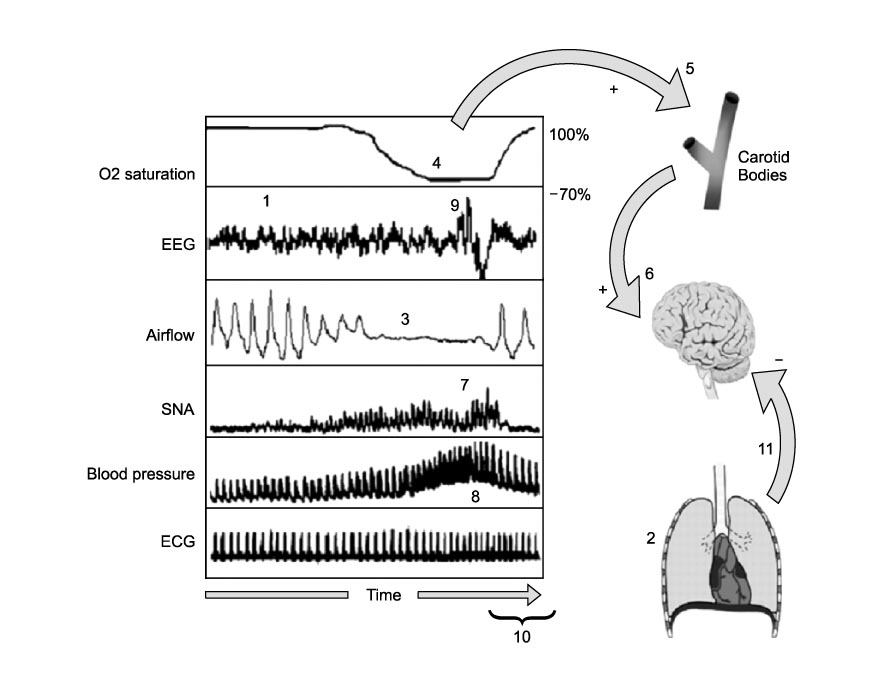Tuberc Respir Dis.
2009 Feb;66(2):83-92.
Pathogenesis and Clinical Features of Sleep Breathing Disorder
- Affiliations
-
- 1Division of Respirology, Department of Medicine, Inje University Sanggye Paik Hospital, Seoul, Korea. choisj@paik.ac.kr
Abstract
- No abstract available.
MeSH Terms
Figure
Reference
-
1. Netzer NC. 100 years ATS-30 years respiratory sleep medicine-where to go? Report and meeting highlights from 2005 ATS International Conference in San Diego. Sleep Breath. 2005. 9:137–138.2. Davidson TM, Sedgh J, Tran D, Stepnowsky CJ Jr. The anatomic basis for the acquisition of speech and obstructive sleep apnea: evidence from cephalometric analysis supports The Great Leap Forward hypothesis. Sleep Med. 2005. 6:497–505.3. Davidson TM. The Great Leap Forward: the anatomic basis for the acquisition of speech and obstructive sleep apnea. Sleep Med. 2003. 4:185–194.4. White DP. Pathogenesis of obstructive and central sleep apnea. Am J Respir Crit Care Med. 2005. 172:1363–1370.5. Mihaescu M, Murugappan S, Karla M, Khosla S, Gutmark E. Large Eddy Simulation and Reynolds-Averaged Navier-Stokes modeling of flow in a realistic pharyngeal airway model: an investigation of obstructive sleep apnea. J Biomech. 2008. 41:2279–2288.6. Woodson BT, Franco R. Physiology of sleep disordered breathing. Otolaryngol Clin North Am. 2007. 40:691–711.7. Jordan AS, White DP. Pharyngeal motor control and the pathogenesis of obstructive sleep apnea. Respir Physiol Neurobiol. 2008. 160:1–7.8. Patil SP, Punjabi NM, Schneider H, O'Donnell CP, Smith PL, Schwartz AR. A simplified method for measuring critical pressures during sleep in the clinical setting. Am J Respir Crit Care Med. 2004. 170:86–93.9. Farré R, Montserrat JM, Navajas D. Assessment of upper airway mechanics during sleep. Respir Physiol Neurobiol. 2008. 163:74–81.10. Tuck SA, Remmers JE. Mechanical properties of the passive pharynx in Vietnamese pot-bellied pigs. II. Dynamics. J Appl Physiol. 2002. 92:2236–2244.11. Longobardo GS, Evangelisti CJ, Cherniack NS. Analysis of the interplay between neurochemical control of respiration and upper airway mechanics producing upper airway obstruction during sleep in humans. Exp Physiol. 2008. 93:271–287.12. Wellman A, Malhotra A, Jordan AS, Stevenson KE, Gautam S, White DP. Effect of oxygen in obstructive sleep apnea: role of loop gain. Respir Physiol Neurobiol. 2008. 162:144–151.13. Younes M. Contributions of upper airway mechanics and control mechanisms to severity of obstructive apnea. Am J Respir Crit Care Med. 2003. 168:645–658.14. Ramar K, Guilleminaults C. Obstructive sleep apnea: a neurologic disease? Sleep Med Clin. 2008. 3:387–393.15. Guilleminault C, Huang YS, Kirisoglu C, Chan A. Is obstructive sleep apnea syndrome a neurologic disorder? A continuous positivie airway pressure follow-up study. Ann Neurol. 2005. 58:880–887.16. Nguyen AT, Jobin V, Payne R, Beauregard J, Naor N, Kimoff RJ. Laryngeal and velopharyngeal sensory impairment in obstructive sleep apnea. Sleep. 2005. 28:585–593.17. Pillar G, Shehadeh N. Abdominal fat and sleep apnea. The chicken or the egg? Diabetes Care. 2008. 31:S303–S309.18. Vgontzas AN. Does obesity play a major role in the pathogenesis of sleep apnoea and its associated manifestations via inflammation, visceral adiposity, and insulin resistance? Arch Physiol Biochem. 2008. 114:211–223.19. Trakada G, Chrousos G, Pejovic S, Vgontzas A. Sleep apnea and its association with the stress system, inflammation, insulin resistance and visceral obesity. Sleep Med Clin. 2007. 2:251–261.20. Carter R 3rd, Watenpaugh DE. Obesity and obstructive sleep apnea: Or is it OSA and obesity? Pathophysiology. 2008. 15:71–77.21. Peppard PE, Young T, Palta M, Dempsey J, Skatrud J. Longitudinal study of moderate weight change and sleep-disordered breathing. JAMA. 2000. 284:3015–3021.22. Siyam M, Benhamou D. Anaesthetic management of adult patients with obstructive sleep apnea syndrome. Ann Fr Anesth Reanim. 2007. 26:39–52.23. Punjabi NM, Newman AB, Young TB, Resnick HE, Sanders MH. Sleep-disordered breathing and cardiovascular disease: an outcome-based definition of hypopneas. Am J Respir Crit Care Med. 2008. 177:1150–1155.24. Eckert DJ, Malhotra A, Jordan AS. Mechanisms of apnea. Prog Cardiovasc Dis. 2009. 51:313–323.25. Vazir A, Hastings PC, Papaioannou I, Poole-Wilson PA, Cowie MR, Morrell MJ, et al. Variation in severity and type of sleep-disordered breathing throughout 4 nights in patients with heart failure. Respir Med. 2008. 102:831–839.
- Full Text Links
- Actions
-
Cited
- CITED
-
- Close
- Share
- Similar articles
-
- Sleep-Related Breathing Disorders in the Elderly: Clinical Feature, Diagnosis and Treatments
- Management of Frequent Sleep Problem after Stroke
- A Case of Children Suspected as Obstructive Sleep Apnea due to Tubal Tonsillar Hypertrophy
- Epidemiology and Definition of Sleep Disordered Breathing
- Upper airway studies in patients with obstructive sleep apnea syndrome


